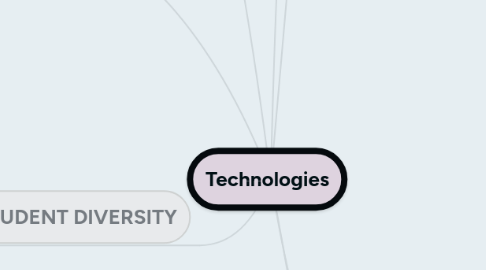
1. STRANDS
1.1. Design and technologies
1.1.1. Knowledge and Understanding
1.1.1.1. Explore and investigate how technology is used it's impact people's lives
1.1.2. Processes and production skills
1.1.2.1. Generate, develop, and communicate design ideas
1.1.2.2. Make designed solutions
1.1.2.3. Evaluate design ideas, processes and solutions
1.2. Digital technologies
1.2.1. Knowledge and Understanding
1.2.1.1. Explore different types of data and how it can be presented in different ways
1.2.1.2. Explore digital systems and different purposes
1.2.2. Processes and production skills
1.2.2.1. Collect and manage data
1.2.2.2. Use digital systems for collecting data
1.2.2.3. Implement digital solutions
1.2.2.3.1. Code Monkey http://dtm4260.edublogs.org/2017/01/12/code-monkey-island-go-bananas-for-programming/
1.2.2.3.2. Cato's Hike http://dtm4260.edublogs.org/2017/01/11/catos-hike-a-programming-adventure/
2. GENERAL CAPABILITIES
2.1. Literacy
2.2. Numeracy
2.3. Information and Communication Technology (ICT)
2.4. Critical and Creative Thinking
2.5. Personal and Social Capability
2.6. Ethical Understanding
2.7. Intercultural Understanding
3. KEY IDEAS: Creating preferred futures
3.1. Project management
3.1.1. Manage projects through planning, organising and monitoring timelines, activities and the use of resources
3.2. Thinking in technologies
3.2.1. Systems thinking
3.2.2. Design thinking
3.2.3. Computational thinking
3.3. Information and communication technology in the Australian Curriculum
3.3.1. Develop knowledge, understanding and skills relating to operating and managing ICT
3.3.2. Helps students to become confident developers of digital solutions
3.4. Safety
3.4.1. Identify and manage risk in technologies
3.4.2. Health, safety and injury prevention
3.5. Animal Ethics
3.5.1. Caring, using, or interacting with animals must comply with the Australian code of practice for the care and use of animals for scientific purposes
4. CURRICULUM AIMS
4.1. Knowledge
4.1.1. Investigate, generate and critique innovative and ethical designed solutions for sustainable futures
4.2. Understanding
4.2.1. Understand the roles and responsibilities of people in design and technologies occupations and how they contribute to society.
4.3. Skills
4.3.1. Produce designed solutions suitable for a range of technologies contexts by selecting and manipulating a range of materials, systems, components, tools and equipment creatively, competently and safely; and managing processes
4.3.2. Use design and systems thinking to generate design ideas and communicate these to a range of audiences
5. STUDENT DIVERSITY
5.1. An Australian curriculum for ALL students
5.1.1. Students with Disabiltiy
5.1.1.1. Curriculum adjustments to provide equitable opportunities
5.1.1.2. Draw from different curriculum year levels
5.1.2. Gifted and talented
5.1.2.1. Emphasise aspects from general capabilities; criticaland creative thinking
5.1.2.2. Draw from later bands in the Australian Curriculum
5.1.3. English as an additional language/dialect
5.1.3.1. Allow for additional time and support
5.1.3.2. Exlicitly addresses their language needs
6. CROSS CURRICULUM PRIORITIES
6.1. Aboriginal and Torres Strait Islander Histories and Cultures
6.1.1. Identify, explore, understand and analyse the interconnectedness between technologies and Identity, People, Culture and Country/Place
6.1.2. Apply this knowledge and understanding within Design and Technologies and Digital Technologies
6.2. Asia and Australia’s Engagement with Asia
6.2.1. Explore traditional, contemporary and emerging technological achievements in the countries of theAsia region
6.2.2. Apply this knowledge and understanding to create appropriate and sustainable products that reflect intercultural, creative and critical thinking
6.3. Sustainability
6.3.1. Focus on the knowledge, understanding and skills necessary to choose technologies and systems with regard to costs and benefits
6.3.2. Reflect on past and current practices, and assess new and emerging technologies from a sustainability perspective.
7. ACHIEVEMENT STANDARDS
7.1. F-2
7.1.1. Describe the purpose of technologies
7.1.2. List the features of technologies that influence design decisions and identify how digital systems are used.
7.1.3. Collect, sort and display familiar data from a range of sources - recognise patterns in data.
7.1.4. Record design ideas using techniques; labelled drawings, lists and sequenced instructions.
7.1.5. Design solutions to simple problems.
7.1.6. Evaluate their ideas, information and solutions
7.1.7. Safely create solutions and communicate ideas and information face-to-face and online.
7.2. 3-4
7.2.1. Describe how social, technical and sustainability factors influence the design of solutions to meet present and future needs.
7.2.2. Collect, manipulate and interpret data from a range of sources
7.2.3. Describe features and uses of technologies that influence design decision
7.2.4. Use technical terms and graphical and non-graphical representation techniques including algorithms.
7.2.5. Plan a sequence of steps (algorithms) to create solutions and plan and safely produce designed solutions
7.2.6. Use identified criteria for success, including sustainability considerations.
7.2.7. Use agreed protocols when collaborating, and creating and communicating ideas, information and solutions face-to-face and online.
7.3. 5-6
7.3.1. Explain how social, ethical, technical and sustainability considerations influence the design of solutions to meet a range of present and future needs.
7.3.2. Describe a range of needs, opportunities or problems and define them in terms of functional requirements.
7.3.3. Collect and validate data from a range of sources to assist in making judgements.
7.3.4. Generate and record design ideas for specified audiences using appropriate technical terms, and graphical and non-graphical representation techniques.
7.3.5. Plan, design, test, modify and create digital solutions that meet intended purposes including user interfaces and a visual program.
7.3.6. Negotiate criteria for success, including sustainability considerations.
7.3.7. Use ethical, social and technical protocols when collaborating, and creating and communicating ideas, information and solutions face-to-face and online.
7.3.8. Explain how the features of technologies influence design decisions and how digital systems are connected to form networks.
